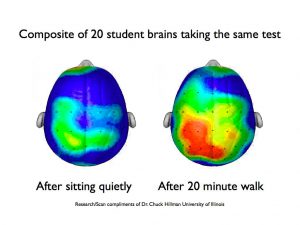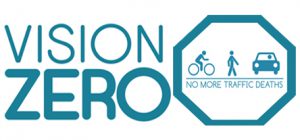In a webinar presented by Coach Paul Zientarski of Naperville, Illinois, the main focus is on the importance of physical activity being implemented in schools and the positive effects of physical education programs. Not only can physical activity influence one’s body and weight, it also impacts the mind and can improve learning. Exercise prepares the mind in a number of ways, including improvements in impulse control, attention, and behavior. The webinar included evidence from previous studies that have shown the effects on the brain when physical activity is present in a child’s day. One example showed the comparisons of brain activity of students that were sitting quietly before taking a test and those that had taken a 20-minute walk before the test. Results showed that while taking the test, those that had walked for 20 minutes were using more brain activity than those that had not taken a walk beforehand (image below). Based on this result, even the simple movement of walking can enhance the brain and prepare it for learning.
Paul Zientarski also discussed his own program, Learning-Readiness Physical Education (LRPE). The physical education course took place before a reading class, so that the influence of physical activity on learning and achievement in the classroom could be measured. The program included different components such as core strength, cross lateral activities, team building, and academic support while exercising. Academic support while exercising allowed students to study or do some type of academic tasks while doing low-intensity activity such as riding a stationery bike. By the end of the semester, kids in the exercise class did 56% better in the reading class than the ones that did not participate. The school was so impressed with these results, they did the same program with children struggling in a math class and saw improvements with that as well. Similar programs are being implemented in schools across the country, so it is possible to use this intervention in a variety of communities and schools. These physical activity programs could also be used during the school day to increase standardized test scores, and also show students a way to prepare for tests such as the SAT, ACT, and GRE.
This information could be useful for health educators to take into the schools and promote the positive learning outcomes for students that can come from exercising. This could greatly benefit many school districts that are considering taking out physical education and recess from the school day and help them to understand the many learning benefits that can result from exercise. However, it can only be successful if physical education teachers are willing to work hard and get the children moving and involved. If implemented in an appropriate way, this could lead many school administrators to improving physical education and motivating the physical education teachers to get more involved in programs like LRPE. For more information on the benefits of physical education in schools, check out https://www.cdc.gov/healthyschools/pecat/quality_pe.pdf.
Webinar: http://physicalactivitysociety.org/2016/09/13/naperville-illinois-webinar/







